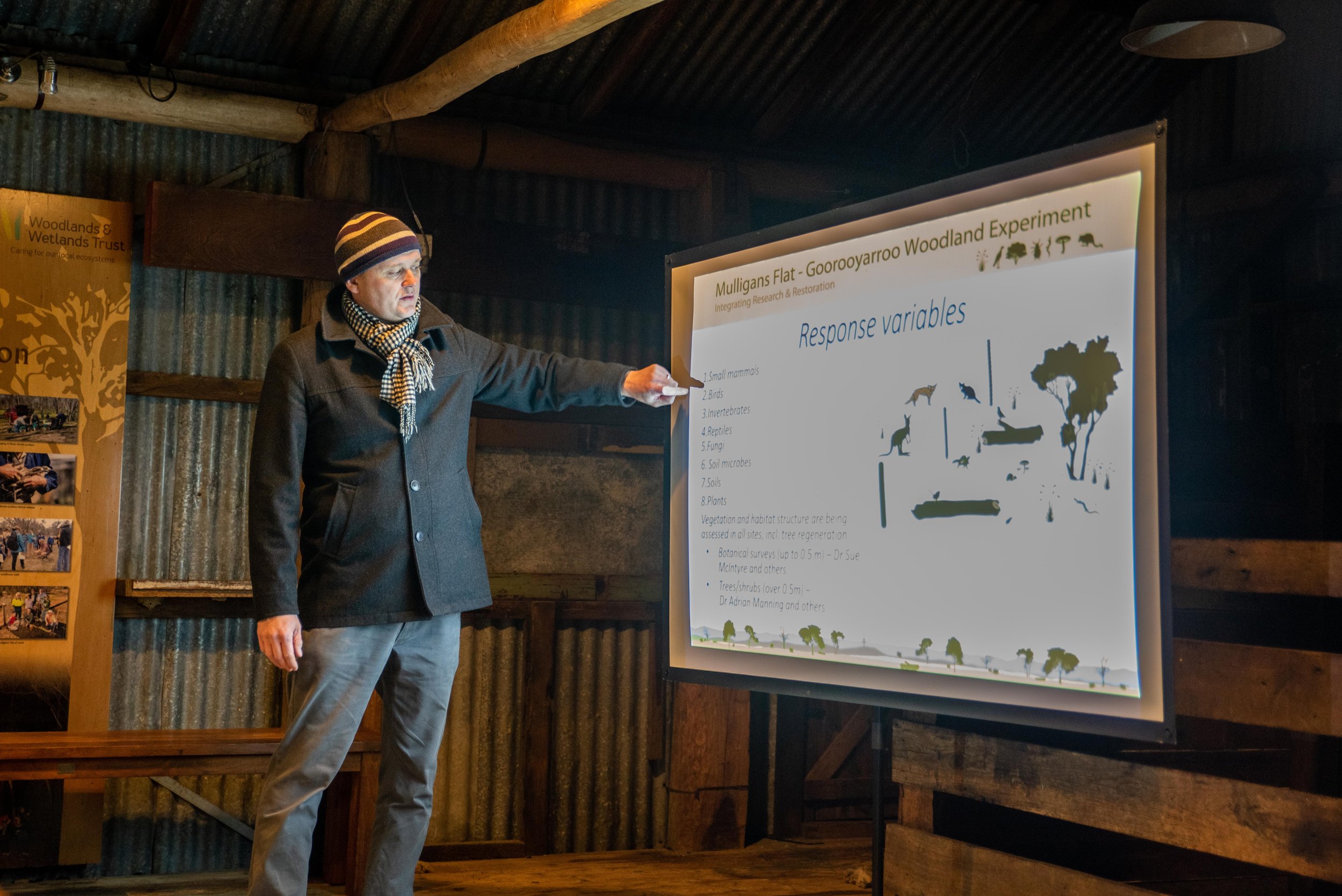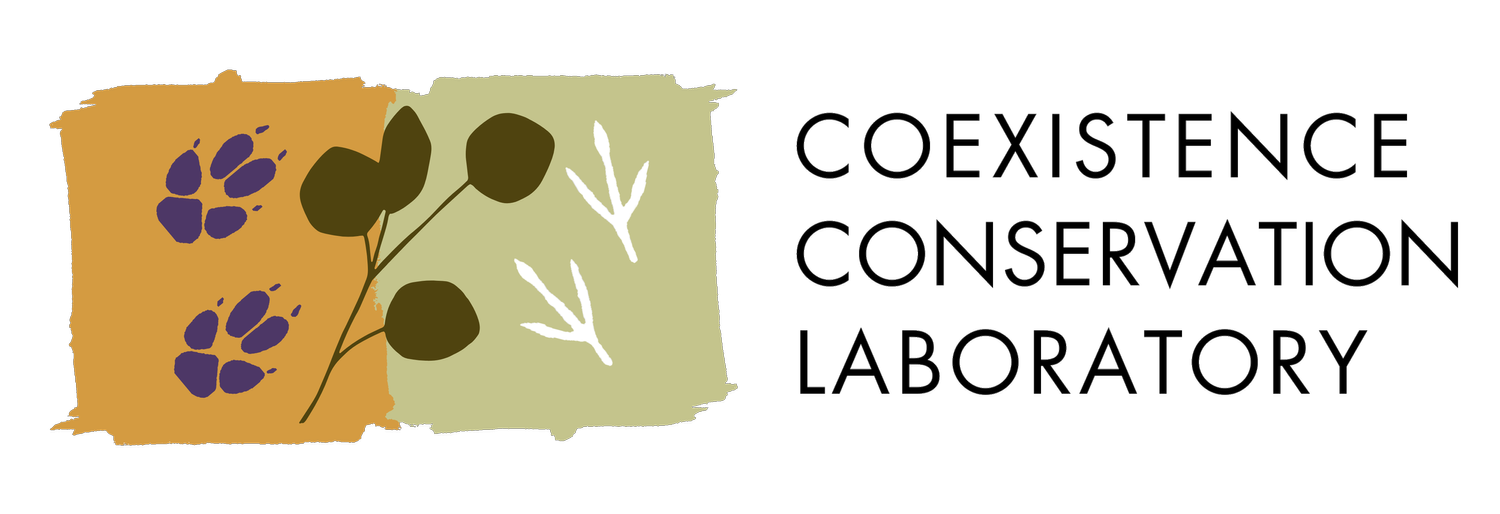
Publications
Recent releases
Pan et al. (2025) Two-way gateway designs to allow free movement between safe havens for bettongs: A captive trial. Ecology and Evolution, 15(e71481).
Shippley et al. (2025) Trophic rewilding: The diet of an opportunistic mesopredator. Biological Conservation, 302(111004).
Smith et al. (2024) Continental-scale identification and prioritisation of potential refugee species; a case study for rodents in Australia. Ecography, e07035.
Gould et al. (2024) A review of electronic devices for tracking small and medium migratory shorebirds. Animal Biotelemetry, 12(11).
Wilson et al. (2024b) The Translocation Continuum Framework for context-specific decision making. Frontiers in Ecology and the Environment, e2784.
Wilson et al. (2024a) Everybody needs good neighbours: movement, habitat use, and conspecific association in a reintroduced mesopredator. Biodiversity and Conservation, 2024.
Publications by theme
-
Gordon et al. (2021) Rewilding lite: Using traditional domestic livestock to achieve rewilding outcomes. Sustainability, 13(6): 3347.
Gordon et al. (2021) Domestic livestock and rewilding: Are they mutually exclusive?. Frontiers in Sustainable Food Systems, 5.
Ross et al. (2020) A reintroduced ecosystem engineer provides a germination niche for native plant species. Biodiversity and Conservation, 29(3): 817—837.
Manning et al. (2020) Woodlands and woody debris: Understanding structure and composition to inform restoration. PLOS One, 15(3): e0224258.
Ross et al. (2019) Effects of digging by a native and introduced ecosystem engineer on soil physical and chemical properties in temperate grassy woodland. PeerJ, 7(8): e7506.
Evans et al. (2019) A long-term experiment reveals strategies for the ecological restoration of reptiles in scattered tree landscapes. Biodiversity and Conservation, 28(11): 2825—2843.
Munro et al. (2019) Returning a lost process by reintroducing a locally extinct digging marsupial. PeerJ, 7(5): e6622.
McIntyre et al. (2017) Trajectories of floristic change in grassland: landscape, land use legacy and seasonal conditions overshadow restoration actions. Applied Vegetation Science, 20(4): 582—593.
Le Roux et al. (2016) Effects of entrance size, tree size and landscape context on nest box occupancy: Considerations for management and biodiversity offsets. Forest Ecology and Management, 366: 135—142.
Le Roux et al. (2016) Enriching small trees with artificial nest boxes cannot mimic the value of large trees for hollow-nesting birds. Restoration Ecology, 24(2): 252—258.
Le Roux et al. (2015) Single large or several small? Applying biogeographic principles to tree-level conservation and biodiversity offsets. Biological Conservation, 191: 558—566.
McIntyre et al. (2014) Restoration of eucalypt grassy woodland: Effects of experimental interventions on ground-layer vegetation. Australian Journal of Botany, 62(7): 570—579.
Manning et al. (2013) Bringing forward the benefits of coarse woody debris in ecosystem recovery under different levels of grazing and vegetation density. Biological Conservation, 157: 204—214.
Shorthouse et al. (2012) The 'making of' the Mulligans Flat - Goorooyarroo experimental restoration project. Ecological Management and Restoration, 13(2): 112-125.
Manning et al. (2011) Integrating research and restoration: The establishment of a long-term woodland experiment in south-eastern Australia. Australian Zoologist, 35(3): 633—648.
Manning et al. (2009) Restoring landscapes of fear with wolves in the Scottish Highlands. Biological Conservation, 142(10): 2314—2321.
Manning et al. (2009) Scattered trees: A complementary strategy for facilitating adaptive responses to climate change in modified landscapes?. Journal of Applied Ecology, 46(4): 915—919.
Lindenmayer et al. (2008) Temporal changes in vertebrates during landscape transformation: A large-scale natural experiment. Ecological Monographs, 78(4): 567—590.
Lindenmayer et al. (2008) A checklist for ecological management of landscapes for conservation. Ecology Letters, 11(1): 78—91.
Manning et al. (2007) A study of coarse woody debris volumes in two box-gum grassy woodland reserves in the Australian Capital Territory. Ecological Management and Restoration, 8(3): 221—224.
Lindenmayer et al. (2007) The complementarity of single-species and ecosystem-oriented research in conservation research. Oikos, 116(7): 1220—1226.
Lindenmayer et al. (2002) The focal-species approach and landscape restoration: A critique. Conservation Biology, 16(2): 338—345.
-
Read et al. (2023) Havens are a pathway, not an endpoint, for species recovery: a response to Woinarski et al. (2023). Biological Conservation, 285: 110212.
Andrewartha et al. (2023) Landscapes of nausea: successful conditioned taste aversion in a wild red fox population. Conservation Science and Practice, 5(8): e12984.
Smith et al. (2022) Mini Safe Havens for population recovery and reintroductions ‘beyond-the-fence’. Biodiversity and conservation, 32(1): 203–225.
Evans et al. (2022) Coexistence conservation: Reconciling threatened species and invasive predators through adaptive ecological and evolutionary approaches. Conservation Science and Practice, 4(7): e12742.
Andrewartha et al. (2021) Outfoxing the fox: Effect of prey odor on fox behavior in a pastoral landscape. Conservation Science and Practice, 3(12): e516.
Manning et al. (2021) Bettering the devil you know: Can we drive predator adaptation to restore native fauna? Conservation Science and Practice, 3(8): e447.
Evans et al. (2021) The ‘Goldilocks Zone’ of predation: the level of fox control needed to select predator resistance in a reintroduced mammal in Australia. Biodiversity and Conservation, 30(6): 1731–1752.
-
Shippley et al. (2025) Trophic rewilding: The diet of an opportunistic mesopredator. Biological Conservation, 302(111004).
Silver et al. (2025) A reference genome for the eastern bettong (Bettongia gaimardi). F1000Research, 13(1544).
Rees et al. (2023) Phylogenomic and morphological data reveal hidden patterns of diversity in the national tree of Brazil, Paubrasilia echinate. American Journal of Botany, e16241.
Brockett et al. (2022) Establishment, persistence and the importance of longitudinal monitoring in multi-source reintroductions. Animal Conservation, 25(4): 550–565.
Itoigawa et al. (2022) Functional diversity and evolution of bitter taste receptors in egg-laying mammals. Molecular Biology and Evolution, 39(6): msac107.
-
Gould et al. (2024) A review of electronic devices for tracking small and medium migratory shorebirds. Animal Biotelemetry, 12(11).
Shokirov et al. (2024) Using multiplatform LiDAR to identify relationships between vegetation structure and the abundance and diversity of woodland reptiles and amphibians. Remote Sensing in Ecology and Conservation, 2024.
Cobden et al. (2023) High nest survival, but variable reproductive output in the Superb Parrot (Polytelis swainsonii). Emu, 123(1): 14—23.
Shokirov et al. (2023) Habitat highs and lows: Using terrestrial and UAV LiDAR for modelling avian species richness and abundance in a restored woodland. Remote Sensing of Environment, 285: 113326.
Stojanovic et al. (2023) Reproductive skew in a Vulnerable bird favors breeders that monopolize nest cavities. Animal Conservation, 26: 675–683.
Stojanovic et al. (2021) Suitable nesting sites for specialized cavity dependent wildlife are rare in woodlands. Forest Ecology and Management, 483: 118718.
Evans et al. (2020) Beyond the pond: Terrestrial habitat use by frogs in a changing climate. Biological Conservation, 249: 108712.
Evans et al. (2019) Beetle ecological indicators – a comparison of cost vs reward to understand functional changes in response to restoration actions. Ecological Indicators, 104: 209—218.
Ringma et al. (2019) Systematic planning can rapidly close the protection gap in Australian mammal havens. Conservation Letters, 12(1): e12611.
Le Roux et al. (2018) The value of scattered trees for wildlife: Contrasting effects of landscape context and tree size. Diversity and Distributions, 24(1): 69—81.
Radford et al. (2018) Degrees of population-level susceptibility of Australian terrestrial non-volant mammal species to predation by the introduced red fox (Vulpes vulpes) and feral cat (Felis catus). Wildlife Research, 45(7): 645—657.
Barton et al. (2017) Environmental and spatial drivers of spider diversity at contrasting microhabitats. Austral Ecology, 42(6): 700—710.
Hamonts et al. (2017) Effects of ecological restoration on soil microbial diversity in a temperate grassy woodland. Applied Soil Ecology, 117: 117—128.
Ross et al. (2017) Fine-scale drivers of beetle diversity are affected by vegetation context and agricultural history. Austral Ecology, 42(7): 831—843.
Barton et al. (2016) Substantial long-term effects of carcass addition on soil and plants in a grassy eucalypt woodland. Ecosphere, 7(10): e01537.
Howland et al. (2016) Birds of a feather flock together: Using trait-groups to understand the effect of macropod grazing on birds in grassy habitats. Biological Conservation, 194: 89—99.
Macdonald et al. (2015) Can coarse woody debris be used for carbon storage in open grazed woodlands? Journal of Environmental Quality, 44(4): 1210—1215.
Rayner et al. (2015) Avifauna and urban encroachment in time and space. Diversity and Distributions, 21(4): 428—440.
Barton et al. (2014) Contrasting diversity dynamics of phoretic mites and beetles associated with vertebrate carrion. Experimental and Applied Acarology, 63(1): 1—13.
Howland et al. (2014) Eaten out of house and home: Impacts of grazing on ground-dwelling reptiles in Australian grasslands and grassy woodlands. PLOS One, 9(12): e105966.
Ikin et al. (2014) Bird community responses to the edge between suburbs and reserves. Oecologia, 174(2): 545—557.
Le Roux et al. (2014) Reduced availability of habitat structures in urban landscapes: Implications for policy and practice. Landscape and Urban Planning, 125: 57—64.
Le Roux et al. (2014) The future of large old trees in urban landscapes. PLOS One 9(6): e99403.
Lindenmayer et al. (2014) New policies for old trees: Averting a global crisis in a keystone ecological structure. Conservation Letters, 7(1): 61—69.
Macdonald et al. (2014) Carrion decomposition causes large and lasting effects on soil amino acid and peptide flux. Soil Biology and Biochemistry, 69: 132—140.
Manning et al. (2014) New evidence of late survival of beaver in Britain. Holocene, 24(12): 1849—1855.
Rayner et al. (2014) Evaluating empirical evidence for decline in temperate woodland birds: A nationally threatened assemblage of species. Biological Conservation, 171: 145—155.
Rayner et al. (2014) Are protected areas maintaining bird diversity? Ecography, 37(1): 43—53.
Azhar et al. (2013) Contribution of illegal hunting, culling of pest species, road accidents and feral dogs to biodiversity loss in established oil-palm landscapes. Wildlife Research, 40(1): 1—9.
Azhar et al. (2013) The influence of agricultural system, stand structural complexity and landscape context on foraging birds in oil palm landscapes. Ibis, 155(2): 297—312.
Barton et al. (2013) The role of carrion in maintaining biodiversity and ecological processes in terrestrial ecosystems. Oecologia, 171(4): 761—772.
Barton et al. (2013) Species traits predict assemblage dynamics at ephemeral resource patches created by carrion. PLOS One, 8(1): e53961.
Barton et al. (2013) The spatial scaling of beta diversity. Global Ecology and Biogeography, 22(6): 639—647.
Ikin et al. (2013) Pocket parks in a compact city: How do birds respond to increasing residential density? Landscape Ecology, 28(1): 45—56.
Ikin et al. (2013) The influence of native versus exotic streetscape vegetation on the spatial distribution of birds in suburbs and reserves. Diversity and Distributions, 19(3): 294—306.
Manning et al. (2013) Hollow futures? Tree decline, lag effects and hollow-dependent species. Animal Conservation, 16(4): 395—403.
Ikin et al. (2012) Linking bird species traits to vegetation characteristics in a future urban development zone: Implications for urban planning. Urban Ecosystems, 15(4): 961—977.
Stagoll et al. (2012) Large trees are keystone structures in urban parks. Conservation Letters, 5(2): 115—122.
Azhar et al. (2011) The conservation value of oil palm plantation estates, smallholdings and logged peat swamp forest for birds. Forest Ecology and Management, 262(12): 2306—2315.
Barton et al. (2011) Morphological traits as predictors of diet and microhabitat use in a diverse beetle assemblage. Biological Journal of the Linnean Society, 102(2): 301—310.
Barton et al. (2011) Experimental reduction of native vertebrate grazing and addition of logs benefit beetle diversity at multiple scales. Journal of Applied Ecology, 48(4): 943—951.
Barton et al. (2010) Fine-scale heterogeneity in beetle assemblages under co-occurring Eucalyptus in the same subgenus. Journal of Biogeography, 37(10): 1927—1937.
Manning et al. (2010) Could native scots pines (Pinus sylvestris) still persist in northern England and southern Scotland?. Plant Ecology and Diversity, 3(2): 187—201.
Stagoll et al. (2010) Using bird-habitat relationships to inform urban planning. Landscape and Urban Planning, 98(1): 13—25.
Barton et al. (2009) Conserving ground-dwelling beetles in an endangered woodland community: Multi-scale habitat effects on assemblage diversity. Biological Conservation, 142(8): 1701—1709.
Manning & Lindenmayer (2009) Paddock trees, parrots and agricultural production: An urgent need for large-scale, long-term restoration in south-eastern Australia. Ecological Management and Restoration, 10(2): 126—135.
Gibbons et al. (2008) The future of scattered trees in agricultural landscapes. Conservation Biology, 22(5): 1309—1319.
Manning et al. (2007) Large-scale spatial and temporal dynamics of the vulnerable and highly mobile superb parrot. Journal of Biogeography, 34(2): 289—304.
Fischer et al. (2006) Biodiversity, ecosystem function, and resilience: Ten guiding principles for commodity production landscapes. Frontiers in Ecology and the Environment, 4(2): 80—86.
Manning et al. (2006) Scattered trees are keystone structures - Implications for conservation. Biological Conservation, 132(3): 311—321.
Manning et al. (2006) Multi-scale site and landscape effects on the vulnerable superb parrot of south-eastern Australia during the breeding season. Landscape Ecology, 21(7): 1119—1133.
Manning et al. (2005) A bioclimatic analysis for the highly mobile Superb Parrot of south-eastern Australia. Emu, 105(3): 193—201.
Manning et al. (2004) The conservation implications of bird reproduction in the agricultural matrix: A case study of the vulnerable superb parrot of south-eastern Australia. Biological Conservation, 120(3): 363—374.
-
Smith et al. (2024) Continental‐scale identification and prioritisation of potential refugee species; a case study for rodents in Australia. Ecography, e07035.
Wilson et al. (2024b) The Translocation Continuum Framework for context-specific decision making. Frontiers in Ecology and the Environment, e2784.
Wilson et al. (2024a) Everybody needs good neighbours: movement, habitat use, and conspecific association in a reintroduced mesopredator. Biodiversity and Conservation, 2024.
Wilson et al. (2023) Roadmap to recovery revealed through the reintroduction of an IUCN Red List species. Biodiversity and Conservation, 32(1): 227—248.
Smith et al. (2023) Countering ecological misconceptions with strategic translocation and assessment of microhabitat use. Biological Conservation, 284: 110143.
Evans et al. (2023) Trends in animal translocation research. Ecography, 2023(3): e06528.
Evans et al. (2022) Reintroduction biology and the IUCN Red List: The dominance of species of Least Concern in the peer-reviewed literature. Global Ecology and Conservation, 38: e02242.
Wilson et al. (2022) Personality and plasticity predict post-release performance in a reintroduced mesopredator. Animal Behaviour 187: 177–189.
Wilson et al. (2020) Adapting reintroduction tactics in successive trials increases the likelihood of establishment for an endangered carnivore in a fenced sanctuary. PLOS One, 15(6): e0234455.
Abicair et al. (2020) Habitat selection and genetic diversity of a reintroduced ‘refugee species’. Animal Conservation, 23(3): 330—341.
Portas et al. (2020) Baseline health and disease assessment of founder eastern quolls (Dasyurus viverrinus) during a conservation translocation to mainland Australia. Journal of Wildlife Diseases, 56(3): 547–559.
Manning et al. (2019) Transition to density dependence in a reintroduced ecosystem engineer. Biodiversity and conservation, 28(14): 3803–3830.
Legge et al. (2018) Havens for threatened Australian mammals: The contributions of fenced areas and offshore islands to the protection of mammal species susceptible to introduced predators. Wildlife Research, 45(7): 627–644.
Batson et al. (2017) The effect of pre-release captivity on the stress physiology of a reintroduced population of wild eastern bettongs. Journal of Zoology, 303(4): 311–319.
Portas et al. (2016) Beyond morbidity and mortality in reintroduction programmes: changing health parameters in reintroduced eastern bettongs Bettongia gaimardi. Oryx, 50(4): 674—683.
Batson et al. (2016) The effect of pre-release captivity on post-release performance in reintroduced eastern bettongs Bettongia gaimardi. Oryx, 50(4): 664–673.
Batson et al. (2015) Translocation tactics: a framework to support the IUCN Guidelines for wildlife translocations and improve the quality of applied methods. Journal of Applied Ecology, 52(6): 1598—1607.
Portas et al. (2014) Health evaluation of free-ranging eastern bettongs (Bettongia gaimardi) during translocation for reintroduction in Australia. Journal of Wildlife Diseases, 50(2): 210–223.
Bennett et al. (2013) Causes of reintroduction failure of the brown treecreeper: Implications for ecosystem restoration. AustralEcology, 38(6): 700–712.
Sheean et al. (2012) An assessment of scientific approaches towards species relocations in Australia. Austral Ecology, 37(2): 204–215.
Bennett et al. (2012) The anatomy of a failed reintroduction: A case study with the Brown Treecreeper. Emu, 112(4): 298–312.
Bennett et al. (2012) Habitat selection and post-release movement of reintroduced brown treecreeper individuals in restored temperate woodland. PLOS One, 7(12): e50612.
-
Ikin et al. (2015) Key lessons for achieving biodiversity-sensitive cities and towns. Ecological Management and Restoration, 16(3): 206—214.
Newport et al. (2014) The effects of light and noise from urban development on biodiversity: Implications for protected areas in Australia. Ecological Management and Restoration, 15(3): 204—214.
Manning et al. (2010) Mind the gap: Future depends on sciences and humanities. Nature, 463(7280): 425.
Fischer et al. (2009) Fostering constructive debate: A reply to Chappell et al. Frontiers in Ecology and the Environment, 7(4): 184.
Manning et al. (2009) Landscape fluidity - A unifying perspective for understanding and adapting to global change. Journal of Biogeography, 36(2): 193—199.
Fischer et al. (2008) Should agricultural policies encourage land sparing or wildlife-friendly farming?. Frontiers in Ecology and the Environment, 6(7): 380—385.
Dovers et al. (2008) Uncertainty, complexity and the environment. In G Bammer & M Smithson (ed.), Uncertainty and Risk: Multidisciplinary Perspectives, Earthscan Publications Ltd, London, pp. 245-260.
Fischer et al. (2007) Mind the sustainability gap. Trends in Ecology and Evolution, 22(12): 621—624.
Manning (2007) Ecosystems, ecosystem processes and global change: Implications for landscape design. In DB Lindenmayer & RJ Hobbs (ed.), Managing and Designing Landscapes for Conservation: Moving from Perspectives to Principles, Blackwell Publishing, New Jersey, pp. 347—364.
Manning et al. (2006) Stretch goals and backcasting: Approaches for overcoming barriers to large-scale ecological restoration. Restoration Ecology, 14(4): 487—492.
Manning et al. (2004) Continua and Umwelt: Novel perspectives on viewing landscapes. Oikos, 104(3): 621—628.
Manning et al. (1997) Roman impact on the environment at Hadrian's wall: Precisely dated pollen analysis from Vindolanda, northern England. Holocene, 7(2): 175—186.








